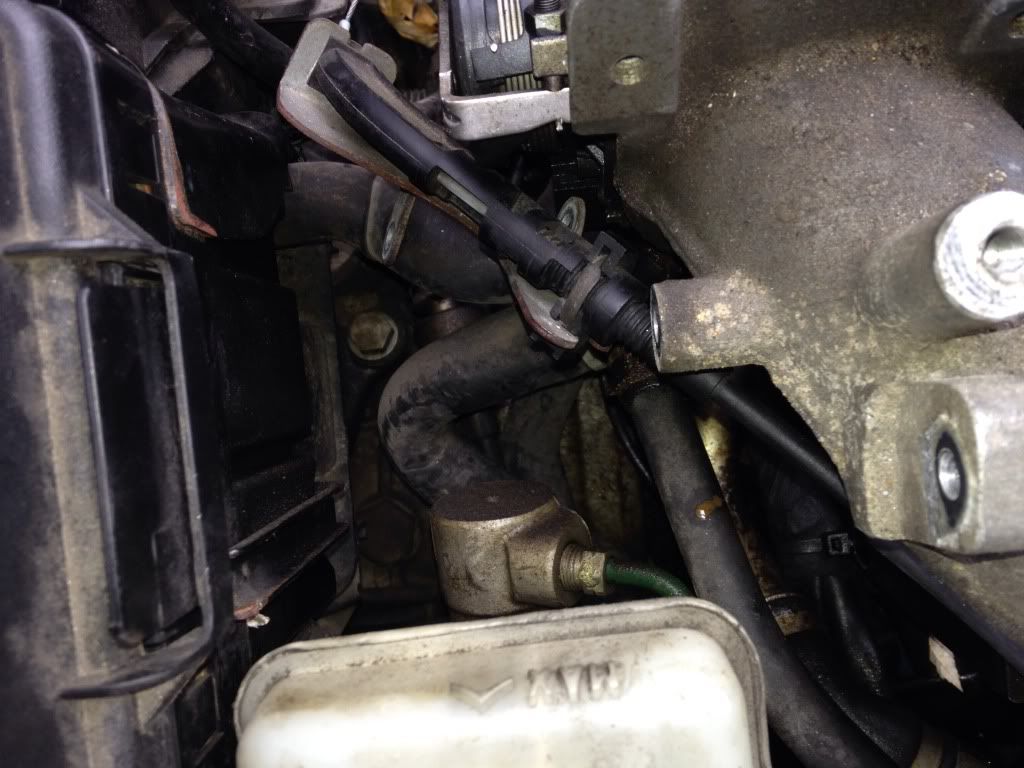Hi,
As promised, I replaced the oil cooler on my V6 and have written a guide to assist others.
Before you start you will need the following:
A new oil cooler
Oil filter
Sump plug washer
Coolant
Oil
RTV Sealant
Loctite 243
A range of torx drivers
A range of star drivers
22mm socket
30mm socket
19mm flare nut (split ring) spanner
usual other sockets
You also need a moderate level of mechanical savvy, and an inane amount of patience. Best get small children well out of earshot...
1. Get car up on stands and remove the lower plastic cover using a small torx and an 8mm socket.
2. Drain oil and coolant.
3. Remove oil filter
4. Upto the top, remove the main plastic engine cover using torx driver
5. You are now presented with an engine and you will need to remove the inlet manifold which is in 3 parts, but before doing so you have a lot of disconnecting to do. Personally I wrap a strip of masking tape around every wire or pipe I disconnect and write on where it goes.
6.Before you effectively open the combustion chambers open to the elememts, I would strongly recommend cleaning and vacuuming out the area surrounding the inlet. There is likely to be a fair bit of crud around there and you dont want it falling into an open bore.
7.Once you are certain you have discinnected every thing to the cast ali inlet plenum you can undo the 7 studs holding it on - 13mm socket.
![Image]()
8.Carefully lift off the plenum and put it somewhere safe from damaging the sealing face.
9.Plug the 6 holes with something ASAP, making sure what you stuff in the holes doesnt introduce anything into the bore.
10.Now remove the middle inlet with the fuel rail complete - 6 off star headed fasteners - you do not need to disconnect the injectors.
![Image]()
11. Place the middle inlet assembly carefully on the rear bank, again protecting the sealing face and bores
12. You can now remove the lower inlet assembly which is a moulded polymer part, 12 off star headed fasteners - same applies with protecting seals etc..
![Image]()
13. You can now see the oil cooler set in between the vee, but you will need to remove the coolant distribution manifold to the right of the cooler, 22mm socket on 2 bolts an pull it to one side. Dont loose the washers...
14. Now undo the oil feed pipes on top of the cooler, 22mm socket again.
15. This is where it gets trickey. The oil pipes are extremely rigid and in order to get the cooler out you need to move them. The right way to do it is to disconnect the pipes at the other end, which is on top of the oil filter housing.
16. This is a pig of a job. First you need to remove the pipe that goes into the front of the filter housing for access(turbo feed?), 13mm socket. It will be tight.
17. Then, with the 19mm split ring spanner you need to remove the 2 pipe nuts in the top of the housing, if it sounds easy it isnt. You are working at some quite unreasonable angles, the nuts are tight and you can only just get a sixth of a turn at a time. I reckon it took me 2 hours in total of mucking about and swearing.
![Image]()
18. Once you have got these out, you should be able to move the pipes at the oil cooler end.
19. Remove the locknuts holding the cooler to the flange, 30mm socket.
20. Remove the 6 off star fasteners holding the flange on an hey presto - there is the cooler. Remove it and now clean out all the coolant and oil in there.
![Image]()
21. Refiting is a reversal of above remembering to clean all mating surfaces and apply liberal amount of RTVsealant around the sealing faces of the oil cooler including the oil pipe connections.
Hope this helps..
Anthony.
As promised, I replaced the oil cooler on my V6 and have written a guide to assist others.
Before you start you will need the following:
A new oil cooler
Oil filter
Sump plug washer
Coolant
Oil
RTV Sealant
Loctite 243
A range of torx drivers
A range of star drivers
22mm socket
30mm socket
19mm flare nut (split ring) spanner
usual other sockets
You also need a moderate level of mechanical savvy, and an inane amount of patience. Best get small children well out of earshot...
1. Get car up on stands and remove the lower plastic cover using a small torx and an 8mm socket.
2. Drain oil and coolant.
3. Remove oil filter
4. Upto the top, remove the main plastic engine cover using torx driver
5. You are now presented with an engine and you will need to remove the inlet manifold which is in 3 parts, but before doing so you have a lot of disconnecting to do. Personally I wrap a strip of masking tape around every wire or pipe I disconnect and write on where it goes.
6.Before you effectively open the combustion chambers open to the elememts, I would strongly recommend cleaning and vacuuming out the area surrounding the inlet. There is likely to be a fair bit of crud around there and you dont want it falling into an open bore.
7.Once you are certain you have discinnected every thing to the cast ali inlet plenum you can undo the 7 studs holding it on - 13mm socket.

8.Carefully lift off the plenum and put it somewhere safe from damaging the sealing face.
9.Plug the 6 holes with something ASAP, making sure what you stuff in the holes doesnt introduce anything into the bore.
10.Now remove the middle inlet with the fuel rail complete - 6 off star headed fasteners - you do not need to disconnect the injectors.

11. Place the middle inlet assembly carefully on the rear bank, again protecting the sealing face and bores
12. You can now remove the lower inlet assembly which is a moulded polymer part, 12 off star headed fasteners - same applies with protecting seals etc..

13. You can now see the oil cooler set in between the vee, but you will need to remove the coolant distribution manifold to the right of the cooler, 22mm socket on 2 bolts an pull it to one side. Dont loose the washers...
14. Now undo the oil feed pipes on top of the cooler, 22mm socket again.
15. This is where it gets trickey. The oil pipes are extremely rigid and in order to get the cooler out you need to move them. The right way to do it is to disconnect the pipes at the other end, which is on top of the oil filter housing.
16. This is a pig of a job. First you need to remove the pipe that goes into the front of the filter housing for access(turbo feed?), 13mm socket. It will be tight.
17. Then, with the 19mm split ring spanner you need to remove the 2 pipe nuts in the top of the housing, if it sounds easy it isnt. You are working at some quite unreasonable angles, the nuts are tight and you can only just get a sixth of a turn at a time. I reckon it took me 2 hours in total of mucking about and swearing.

18. Once you have got these out, you should be able to move the pipes at the oil cooler end.
19. Remove the locknuts holding the cooler to the flange, 30mm socket.
20. Remove the 6 off star fasteners holding the flange on an hey presto - there is the cooler. Remove it and now clean out all the coolant and oil in there.

21. Refiting is a reversal of above remembering to clean all mating surfaces and apply liberal amount of RTVsealant around the sealing faces of the oil cooler including the oil pipe connections.
Hope this helps..
Anthony.














